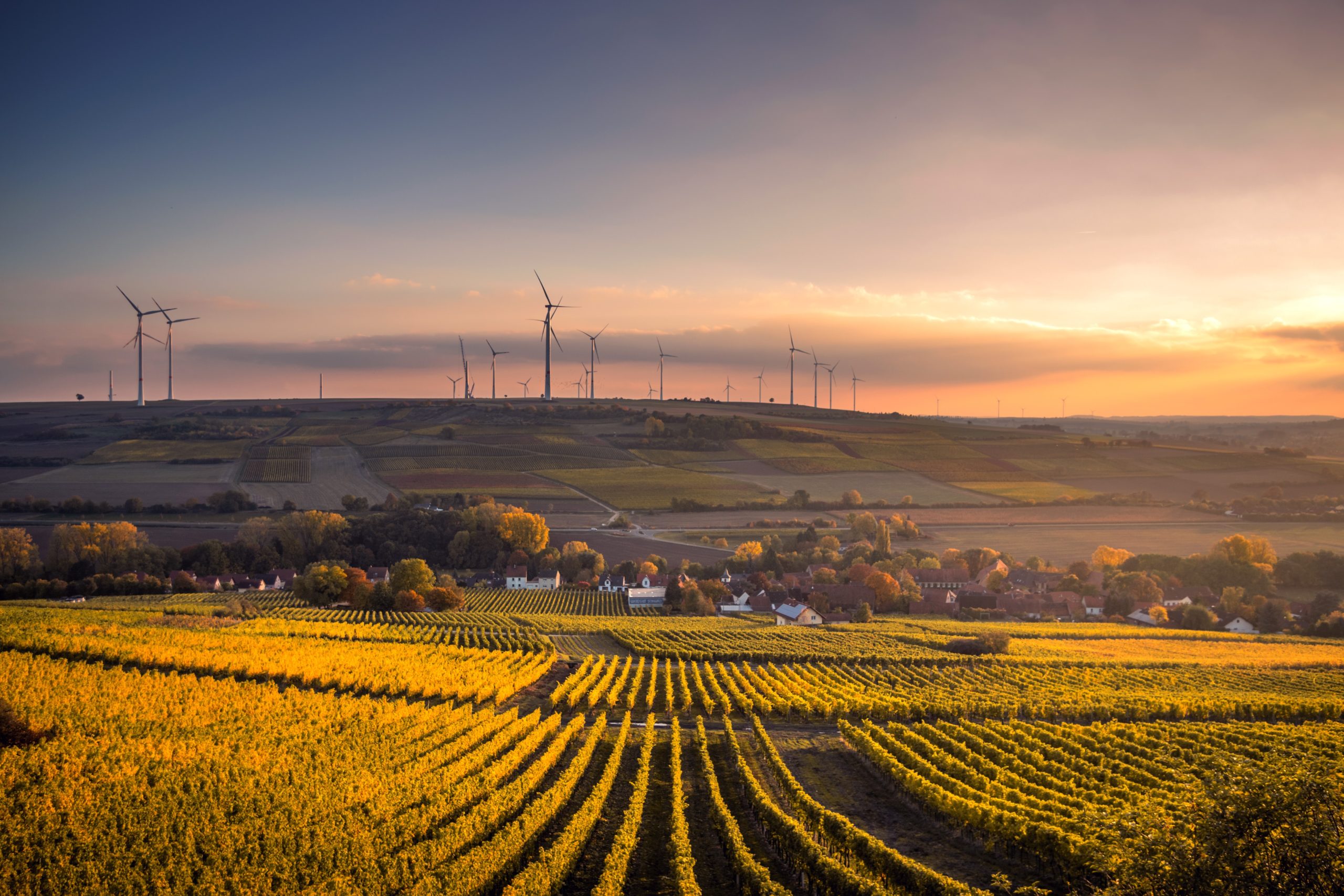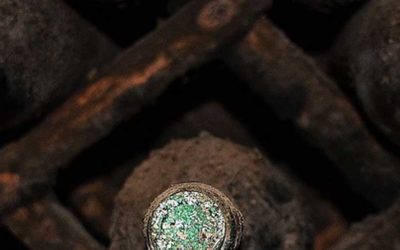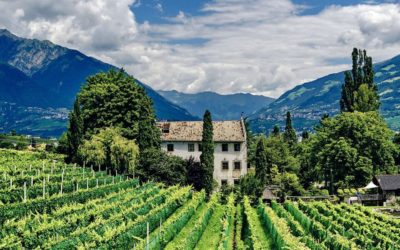Deutschland
Rheingau
Der Rheingau zählt mit seiner sehr langen Geschichte zu einem der altehrwürdigen Anbaugebiete Deutschlands. Weltweit bekannt ist der Rheingau für seine exzellenten Rieslinge, aber auch herausragende Spätburgunder, wie sie z.B. in Assmannshausen gedeihen. Berühmte Weinbauorte sind beispielsweise Hochheim am Main, Walluf, Eltville am Rhein, Kiedrich, Oestrich-Winkel, Geisenheim, Johannisberg, Rüdesheim und Assmannshausen. Der Rheingau hat insgesamt etwa 3100 Hektar Rebfläche, zu welcher sogar noch ein Teil in Frankfurt am Main befindet (Lohrberger Hang), und erstreckt sich westlich des Rhein-Main-Gebietes rechtsseitig des Rheins. Top-Lagen sind beispielshalber der Kiedricher Gräfenberg, Erbacher Marcobrunn, Hattenheimer Nussbrunnen, Hattenheimer Wisselbrunnen, Oestricher Lenchen, Oestricher Doosberg, Mittelheimer St. Nikolaus, Hattenheimer Steinberg, Assmannshäuser Höllenberg, Hochheimer Hölle und der Rüdesheimer Berg mit Schlossberg, Rottland und Roseneck.
Berühmte Weingüter sind:
- Weingut Künstler
- Weingut Robert Weil
- Weingut J.B. Becker
- Weingut Peter Jakob Kühn
- Weingut Leitz
- Weingut Georg Breuer
- Schloss Johannisberg
- Schloss Vollrads
- Schloss Reinhartshausen
- Weingut Balthasar Ress
- Weingut August Kesseler
- Weingut von Oetinger
- Weingut Chat Sauvage
- Weingut Geheimrat J. Wegeler Gutshaus Rheingau
- Weingut Josef Spreitzer
- Weingut Langwerth von Simmern
- Staatsweingut Kloster Eberbach
Mosel-Saar-Ruwer
Das Anbaugebiet Mosel-Saar-Ruwer liegt entlang den gleichnamigen drei Flüssen und befindet sich in den Bundesländern Rheinland-Pfalz und Saarland. Hier ist eine Gesamtfläche von etwa 8600 Hektar bestockt.
Zu Weltruhm gelangte die Mosel durch die Vielzahl der teils extrem steilen Weinberge und die dort wachsenden ausgezeichneten Rieslinge. Spitzenlagen sind z.B. Graacher Himmelreich, Zeltinger Himmelreich, Erdener Treppchen, Erdener Prälat, Bernkasteler Doctor, Scharzhofberg, Kanzemer Altenberg, Ockfener Bockstein, Saarburger Rausch, Ürziger Würzgarten, Wehlener Sonnenuhr. Das besondere an den Moselweinen ist die von den sehr steinigen Steillagen herrührende Mineralität, die filigrane Säure und die sehr moderaten Alkoholwerte. Dieses Zusammenspiel lässt Weine von großer Feinheit entstehen, welche weltweit in dieser Weise fast nur hier zu finden sind. Berühmte Weinbauorte sind etwa Wiltingen, Kanzem, Ürzig, Traben-Trarbach, Bernkastel-Kues, Neumagen-Dhron, Wehlen und Zeltingen.
Bekannte Weingüter sind:
- Weingut Markus Molitor
- Weingut Forstmeister Geltz-Zilliken
- Weingut Van Volxem
- Weingut Egon Müller
- Weingut Dr. Loosen
- Weingut Fritz Haag
- Weingut Heymann-Löwenstein
- Weingut J. J. Prüm
- Weingut Karthäuserhof
- Weingut Maximin Grünhaus
- Weingut Peter Lauer
- Schloss Lieser
- Schloss Saarstein
- Weingut Geheimrat J. Wegeler Gutshaus Mosel
- Weingut St. Urbanshof
- Weingut Reichsgraf von Kesselstatt
- Weingut von Othegraven
- Weingut Knebel
Pfalz
Das Weinbaugebiet Pfalz ist mit etwa 23.000 Hektar Rebfläche das zweitgrößte Anbaugebiet Deutschlands. Es ist in die Bereiche Mittelhaardt/Deutsche Weinstraße und Südliche Weinstraße unterteilt und reicht von Kirchheim-Bolanden im Norden bis runter nach Schweigen an die französische Grenze im Süden. Die am meisten angebauten weißen Rebsorten sind Riesling, Müller-Thurgau und Silvaner. Zunehmende Bedeutung wird in der letzten Zeit auch Grauburgunder, Weißburgunder und Chardonnay zugemessen. Bei den roten Rebsorten haben Dornfelder, Portugieser und Spätburgunder (Pinot Noir) die größten Anteile. Aber auch hier sind die internationalen Rebsorten Cabernet Sauvignon und Merlot auf dem Vormarsch. Die bekanntesten Weinbaugemeinden sind Bad Dürkheim, Deidesheim, Forst, Ruppertsberg, Siebeldingen, Birkweiler, Schweigen, Neustadt an der Weinstraße und Gimmeldingen.
Die besten Lagen der Pfalz sind z.b. Forster Kirchenstück, Forster Ungeheuer, Forster Jesuitengarten, Forster Pechstein, Birkweiler Kastanienbusch, Deidesheimer Langenmorgen, Königsbacher Idig, Kallstadter Saumagen und Siebeldinger Im Sonnenschein.
Spitzenweingüter sind z.b.:
- Weingut Von Winning
- Weingut Reichsrat von Buhl
- Weingut Bassermann-Jordan
- Weingut Friedrich Becker
- Weingut Dr. Bürklin-Wolf
- Weingut Christmann
- Weingut Knipser
- Weingut Philipp Kuhn
- Weingut Müller-Catoir
- Weingut Ökonomierat Rebholz
- Weingut Koehler-Ruprecht
Franken
Das Anbaugebiet Franken befindet sich im Nordwesten der Frankenregion und ist hauptsächlich an den Flüssen Main, Wern und Fränkische Saale gelegen. Hier befinden sich insgesamt ungefähr 6200 Hektar Rebfläche. Die wichtigsten weißen Rebsorten sind Müller-Thurgau, Silvaner und Riesling, wobei hier in Franken vor allem der Silvaner eine besonderes Ansehen genießt. In letzter Zeit steigend sind auch die Anteile an Rotwein (derzeit ungefähr 19%), wo hier Domina, Spätburgunder und Dornfelder als Rebsorten die größte Rolle spielen. Eine Besonderheit des Weinbaugebiets ist die Abfüllung hiesiger Weine in sogenannte „Bocksbeutel“, welche eine bauchige Flaschenform aufweisen. Bekannte Weinbauorte sind z.B. Würzburg, Klingenberg, Bürgstadt, Retzstadt, Stetten und Escherndorf. Paradelagen in Franken sind beispielsweise Würzburger Stein, Bürgstädter Centgrafenberg, Bürgstädter Hundsrück, Escherndorfer Lump und Klingenberger Schlossberg.
Top-Weingüter sind hier z.B.:
- Weingut Bürgerspital zum Heiligen Geist
- Weingut Fürstlich Castell’sches Domänenamt
- Weingut Rudolf Fürst
- Weingut Juliusspital
- Weingut Rudolf May
- Weingut Horst Sauer
- Weingut Rainer Sauer
- Weingut der Stadt Klingenberg – Benedikt Baltes
- Weingut am Stein – Ludwig Knoll
- Weingut Hans Wirsching
- Weingut Zehnthof Luckert
Rheinhessen
Das Weinbaugebiet Rheinhessen ist im Dreieck zwischen Mainz, Bingen und Worms gelegen und bietet mit ca. 26.000 Hektar die größte Weinbergsfläche in einem Anbaugebiet in Deutschland. Die am häufigsten angebauten Rebsorten sind im Weißweinbereich Riesling, Müller-Thurgau, Silvaner und Grauburgunder (Pinot Gris), sowie im Rotweinbereich Dornfelder und Spätburgunder (Pinot Noir). Der Anbau von Weißweinen hat hier deutliches Übergewicht (71%). Weinbauorte sind beispielshalber Flörsheim-Dalsheim, Nierstein, Hohen-Sülzen, Westhofen, Oppenheim, Ingelheim am Rhein oder Bingen.
Herausragende Lagen in Rheinhessen sind z.b. Westhofener Morstein, Westhofener Aulerde, Westhofener Kirchspiel, Dalsheimer Hubacker, sowie Hipping, Pettenthal, Orbel und Ölberg am Roten Hang in Nierstein. Eine Besonderheit ist hier der schon vorher genannte „Rote Hang“, da dieser seinen Namen durch die sehr rote (eisenhaltige) Erde hat, welche in der Form sonst nirgends in der Umgebung zu finden ist.
Spitzenbetriebe sind beispielsweise:
- Weingut Klaus-Peter Keller
- Weingut Wittmann
- Weingut Battenfeld Spanier
- Weingut Kühling-Gillot
- Weingut St. Antony
- Weingut Gunderloch
- Weingut Wagner-Stempel
Baden
Das Weinbaugebiet Baden ist ein langer Streifen, welcher in Tauberfranken bei Tauberbischofsheim beginnt und sich süd-westlich runter bis ins Markgräfler Land und die Schweizer Grenze bei Basel zieht. Auch der Weinbau auf der deutschen Seite des Bodensees gehört zum Anbaugebiet Baden. Baden hat eine bestockte Gesamtfläche von etwa 16.000 Hektar und ist das wärmste Anbaugebiet Deutschlands. Die beliebtesten Rebsorten sind Spätburgunder (Pinot Noir), Regent, Schwarzriesling und Dornfelder bei den Rotweinen und Grauburgunder, Weißburgunder, Chardonnay, Riesling, Gutedel und Müller-Thurgau bei den Weißweinen.
Top-Weinlagen sind z.B. Ihringer Winklerberg, Achkarrer Schlossberg, Oberrotweiler Kirchberg, Oberrotweiler Henkenberg, Malterdinger Bienenberg und Bombacher Sommerhalde.
Spitzenerzeuger sind beispielsweise:
- Weingut Dr. Heger
- Weingut Bernhard Huber
- Weingut Franz Keller
- Weingut Salwey
- Weingut Ziereisen
- Weingut Holger Koch
- Weingut Stigler
Württemberg
Das Weinbaugebiet Württemberg reicht vom unteren Taubertal über Heilbronn und Stuttgart am Neckar entlang bis nach Tübingen. In dieser Gegend ist eine Gesamtrebfläche von etwa 11.300 Hektar zu finden. Württemberg ist vor allem für seine Rotweine, insbesondere den Trollinger bekannt. Weitere häufig angepflanzte Rebsorten sind Schwarzriesling, Lemberger (auch Blaufränkisch genannt) und Spätburgunder für die roten Weine und Riesling, Kerner und Müller-Thurgau für die weißen Weine. Bekannte Weinbauorte sind unter anderem Stetten, Fellbach, Stuttgart, Bönnigheim, Untertürkheim oder Heilbronn. Zu den besten Lagen Württembergs gehören z.B. Fellbacher Lämmler, Untertürkheimer Gips, Bönnigheimer Steingrüben, Hebsacker Berg, Stettener Pulvermächer und Stettener Mönchberg.
Führende Weingüter sind hier z.b.:
- Weingut Aldinger
- Weingut Beurer
- Weingut Dautel
- Weingut Jürgen Ellwanger
- Weingut Karl Haidle
- Weingut Schnaitmann
Ahr
Das Weinanbaugebiet Ahr befindet sich am gleichnamigen Nebenfluss des Rheins, welcher in der Nähe von Remagen in selbigem mündet. An der Ahr sind insgesamt etwa 545 Hektar Weinberge zu finden. Charakteristisch sind die steilen Weinberghänge und der sehr hohe Anteil von roten Rebsorten (ca. 87%) . Diese sind hier hauptsächlich Spätburgunder (Pinot Noir), Blauer Portugieser und Frühburgunder. Bei den weißen sind es überwiegend Riesling, Müller-Thurgau und Weißburgunder. Obwohl die Ahr sehr nördlich ist und normalerweise in dieser Gegend klimatisch bedingt kein Weinbau mehr möglich ist, kann hier dank vieler Sonnenstunden und eines speziellen Mikroklimas dennoch Weinbau betrieben werden. Bekannte Weinbauorte sind beispielsweise Bad Neuenahr-Ahrweiler, Rech, Altenahr und Mayschoss. Top-Weinberge sind z.B. Bad Neuenahrer Sonnenberg, Dernauer Pfarrwingert, Walporzheimer Kräuterberg, Walporzheimer Gärkammer, Ahrweiler Rosenthal, Mayschosser
Mönchberg und Recher Herrenberg.
Top-Erzeuger sind unter anderem:
Nahe
Die Nahe hat insgesamt eine Rebfläche von etwa 4.000 Hektar Rebfläche und umspannt das Gebiet von Bingen den gleichnamigen Fluss Nahe entlang fast bis nach Kirn, sowie auch Teile der Flussarme Glan und Alsenz. Hier wurde auch schon zur Römerzeit Wein angebaut. Die Flächenmäßig führenden weißen Rebsorten sind Riesling, Müller-Thurgau und Silvaner, sowie Dornfelder und Spätburgunder bei den roten Rebsorten. Mit einem Flächenanteil von 75% ist der Weißwein klar dominierend. Berühmte Weinbauorte sind z.B. Bingen, Bad Kreuznach, Bockenau, Niederhausen, Oberhausen, Schlossböckelheim und Monzingen.
Spitzenlagen an der Nahe sind etwa Norheimer Dellchen, Oberhäuser Brücke, Monzinger Halenberg, Monzinger Frühlingsplätzchen, Niederhäuser Hermannshöhle, Schlossböckelheimer Kupfergrube, Dorsheimer Pittermännchen, Dorsheimer Goldloch und Bockenauer Felseneck.
Top-Weingüter sind hier z.B.:
- Weingut Dönnhoff
- Weingut Schäfer-Fröhlich
- Weingut Emrich-Schönleber
- Gut Hermannsberg
- Schlossgut Diel



